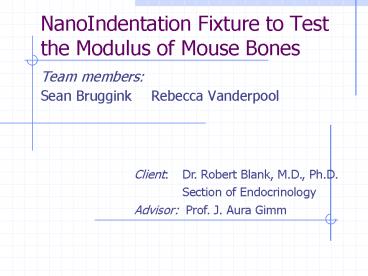NanoIndentation Fixture to Test the Modulus of Mouse Bones - PowerPoint PPT Presentation
1 / 17
Title:
NanoIndentation Fixture to Test the Modulus of Mouse Bones
Description:
NanoIndentation Fixture to Test the Modulus of Mouse Bones. Team members: ... Particles line up while magnetic field is applied. ... – PowerPoint PPT presentation
Number of Views:50
Avg rating:3.0/5.0
Title: NanoIndentation Fixture to Test the Modulus of Mouse Bones
1
NanoIndentation Fixture to Test the Modulus of
Mouse Bones
- Team members
- Sean Bruggink Rebecca Vanderpool
- Client Dr. Robert Blank, M.D., Ph.D.
- Section of Endocrinology
- Advisor Prof. J. Aura Gimm
2
Overview
- Problem Statement
- Background
- Alternative Solutions
- Proposed Solution
- Future Plan
3
Problem Statement
- The goal of this project is to design a device
that will function to test the mechanical
strength of mouse bones with the use of a micro
indentation test. The examination of the extent
of the indentation will lead to the analysis of
the mechanical properties of the mouse tibia. The
analysis of the mechanical properties of the
bones can lead to the isolation of the gene that
influences the hardness of the mouse bone. This
can then be correlated to the human genome.
4
Background
- Isolation of Hardness gene of bones in Mice
- 3pt. Strength Test
Insertion of needle and guidewire
5
Existing Mechanical Tests
- 3pt. Strength test
- Fixed at 2 pts.
- Force applied between points.
- Measures the energy to failure of bone
- Current problems
- Dependent on geometry of bone
- Prone to error
3pt Strength test.
www.mts.com/materials/Solutions_0207/app_extra_027
.htm
6
Micro-Indentation Tests
- Measures applied force over bone displacement on
a micro-scale - Measures tissue strength instead of Geometry
- Basic procedure
- Fixation of specimen
- Sanding of specimen
- Indentation of specimen with a form of a
microindenter (Vickers)
Representative Nanoindentation Device (Kishen
2000).
7
Important Specifications
- Indenter
- Apply a force between 0-1N
- Control Load while keeping displacement variable
- Easy to attach to current load cell, 1/4 drive
socket - Diameter of 0.01 mm and diamond tipped
8
Specifications cont
- Bone Fixation Device
- Attach to current MTS 858 Bionix testing machine,
3/8 drive socket - Firmly hold bone in place during testing
- Sanding Procedure
- Obtain a homogenous flat surface with a minimal
amount of bone removed.
5000 lbs Load Cell used as Testing base
9
2 Vibrational Disruption
- Apply high frequency physical vibration
- Flexible cylinder
- In molecular level
- Drawback
- Cost
- Suitable material
Vibrational Changes
10
3 Memory Metal
- Controlled by temperature
- Programmable
- e.g. Nitinol (nickel titanium).
- Drawback
- Temp change affect homeostasis
- Only reverts back to memory position
11
4 Phase Changing Material
- Magneto-Rheological Fluid (MR)
- Size in micron.
- Change phase in millisecond.
- Programmable.
- Particles line up while magnetic field is
applied. - Highly controllable stiffness by degree of
magnetic field.
http//www.rheonetic.com/
12
4 Phase Changing Material MR
- Advantage
- Small size.
- Quick phase changing.
- Highly controllable
- Disadvantage
- Belong to Lord Corporation
- Require technical knowledge
http//www.rheonetic.com/
13
5 Mechanical System with Phase Changing Material
- Uniform matrix
- Matrices impede fluid flow in most viscous form
- Complicated construction (involving precision on
small scale)
Spiral Matrix
14
5 Condt
- Foam Matrix
- Lattice Matrix
- Impede flow of fluid
- Matrix could be injected into the hollow tube
Schematic drawings of non-uniform matrices
15
Proposed Solution
- MR Fluid
- Containment Tube
- Solenoid
16
Future Plan
- Contact Lord Corporation
- Test the stiffness of existing guidewire
- Find out the effect of magnetic field on MR
quantitatively - Perform experiment on the mechanisms
17
Special Thanks to
- Dr. Victor Haughton
- Prof. Paul Thompson
Thanks for coming
Questions???































